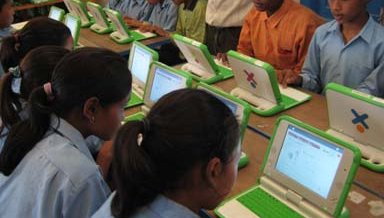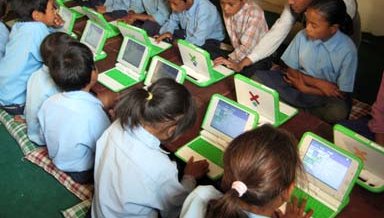This is a compilation of observations from the first week of the laptop implementation at the two rural schools in Nepal — Bashuki and Bishwamitra Ganesh. After the launch of the project on April 25th, we visited the schools for the next six days, spending entire days working with the teachers and observing the classrooms. This was the second part of the teacher training program, with the first part being the 4 day residential program that was help from March 29 till April 1. Typically, the day would start with discussion of the day’s lesson plans with the teachers, and then we would proceed to observe the classes where the teachers used the learning activities developed by OLE Nepal in the daily teaching. The details of the teacher training program can be found in Dr. Bhatta’s post. Here I will write about general observations about the children and the laptops at the two schools.
Between the two test schools, Bashuki is undoubtedly the more challenging one. The school located near a hilltop in Lakurebhanjyang serves a community of Tamang people, an indigenous group that inhabit the hilly region. Most students come from poor families that depend on agriculture and menial work to make ends meet. The literacy rate is quite low, but the teachers are determined to change this. However, they face a daunting uphill task to educate children from villages where sending kids to school means losing extra hands to work the fields. Furthermore, out of the 10 teachers, only one is from the local community, while the rest have to trek up at least 1 hour each day to reach the school. In this respect, the school is quite detached from the community. Most teachers do not speak the local Tamang language, while few understand it. Overall, it is not easy for the teachers to mix in with the local people and interact with them.
We had distributed a total of 75 laptops – 39 to grade 2 students, and 36 to grade 6 students. During the first week of school, the attendance was not very encouraging. Most of the week there were between 25-30 students in grade 2, and 20-25 students in grade 6. This could be due to the fact that there was no clear indication of when classes were supposed to begin, a typical problem faced by schools all over Nepal. According the ministry, public schools across the nation were supposed to start classes on April 17th, but due to various reasons, this rarely happens in most schools. Ironically, schools are required keep admissions open till mid-May. To make things worse, textbooks had not been delivered to the schools till date. These are ground realities that teachers and school administrations have to deal with in educating children in rural areas. Nevertheless, it was quite surprising that even the lure of the cute laptops were not enough to entice the students to school. The teachers told us that full attendance is a rarity because siblings take turns between going to school and staying home to help in the fields and do household chores.
The School Management Committee (SMC) and school administration had jointly decided not to send the laptops home with the students during the first week. They wanted the children to get more familiar with the laptops before they take them home with them. While we first were not happy with the plan, in retrospect, it turned out to be a good idea given the number of students that did not show up at school after the distribution day. Since the students had limited time with the XO’s during this week, they were not quite familiar with the laptops in the classroom.

This school located in a wooded area in Jyamirkot serves a mixed community consisting of Brahmin, Chhetri, Newar, Tamang and Dalit groups. The school has a core group of dedicated teachers who have been affiliated with the school for over 20 years. Three of the twelve teachers had at one time attended the school. Almost all the teachers hail from the surrounding villages, and they are very tied to the local community. They have close relation with the parents and the community. People in the community put high value on education. Hence, we see that it will be easier to successfully implement the project in this school.
Students from both grades were allowed to take the laptops home from the very first day. Out of the 38 students in grade 6 and 22 in grade 2, almost all of them were present throughout the first week of classes. The teachers conducted regular classes for all grades during this period.
Since the students had extra personal time at home with the XO’s they were very much familiar using the XO’s in classrooms. Even the second graders were navigating around the XO without much problem, and were able to get to the activities that the teachers were referring to. The sixth graders had tried out other activities besides the E-Paati activities developed by OLE Nepal.

Dissection of Cursor Problem
We encountered the jumpy cursor problem at both schools, but there were many more cases at Bashuki. At Bishwamitra, out of 60 laptops, there were approximately 5-6 reports of jumpy cursor problem. At Bashuki, the problem was found in more than half the laptops. We will go back to the schools this week and report back on the status of the problem. We also plan to do a more systematic collection of data regarding the cursor problem.
One factor contributing to the higher number of cases at Bashuki is dust. The school area is quite dusty, and in the afternoon, when the wind picks up, there would be so much dust in the air that at times it becomes very difficult to walk outside with your eyes open. It takes only a few minutes before a layer of dust settles on any surface. The classrooms have windows made out of wood, and at least one or two have to be left open to let light into the rooms. As a result, dust particles gather on the XO’s, and could be felt them on the touch pad. Students at the schools were seen carrying soft pieces of cloth to wipe the screen and touchpad.
Dust by itself may not have been a problem. In couple cases, the jumpy cursor problem was fixed when dust was wiped from the touchpad. But when the laptops were returned to the kids, the jumpy cursor problem resurfaced. That is when I realized that a combination of sweaty fingers and dust could have made it worse. Most of the kids had sweaty hands, and with dust all around, their finger tips were not clean. Since the touchpad work by sensing the capacitance of the finger, moist or sweaty fingers can be problematic.
Since the other school, Bishwamitra in not in a dusty location, the cursor problem was not as pervasive. Furthermore, the school was located in a much cooler location, and we noticed that the kids had cleaner hands. The couple cases of jumpy cursor problem at this school were resolved by simply rebooting the laptops.
In almost all cases, the jumpy cursor problem could be temporarily fixed by restarting the laptops. However, this was temporary, and the problem would return shortly after the kids start using the laptops.
Next Steps
Bashuki School, with all its problems, represents a typical government schools in Nepal. Bishwamitra School is more of an exception, and we cannot expect to find schools like that when we expand the project in other districts. So, our challenge is to find ways to make the project successful at Bashuki, and the lessons learned there will be invaluable to us when we reach out to similar schools in far flung districts in the country. So how do we do it? Obviously, it requires a lot of effort from all stakeholders, including teachers and SMC.
We can start off by having regular interactions between teachers of the two schools. In fact this was proposed by teachers at Bishwamitra. Teachers from each school can arrange to visit the other school. Such visits will help teachers at Bashuki learn from the way things are done at Bishwamitra, while the teachers at Biswhamitra can learn about the problems faced by their counterparts at Bashuki and make suggestions to improve the situation.
We need to start working closely with the community in Bashuki with the help of the SMC and the school administration. It is important for the community to understand the project and own it. The teachers had organized an orientation program the week before the launch of the project, but the turnout was not very good. It is also important that we have someone communicate with the parents in the local Tamang language. Since no one in our team knows the language, we plan to work with the only teacher who hails from the local community. Also, the SMC consists of mostly local Tamang leaders who can also help in reaching out to the community.
We will also start collecting attendance data so that we can better understand the attendance pattern. This will be essential if we are to work with the community to figure out how to increase attendance in the classes. We will also start collecting real data regarding the various technical problems that are encountered at the schools.

Network and Power
The students have not yet reached the point where they are utilizing the networking capabilities of the laptops. While this may seem odd, we have to understand that these children have never touched a computer before. They are still intrigued by the various games and activities that they can access in the laptop without connecting to the network. We will soon work with the teachers to demonstrate the mesh networking capabilities of the laptops, as well as show them how to access the E-Pustakalaya (electronic library) that we have built. Both the electronic library and the Internet will be accessed via the wireless network that we have set up to connect the schools to the Department of Education and our office.
We have not been able to have the Internet accessible from the homes. This is the next challenge for our networking team. The students live as far as 45 minutes walk from the school, and due to the hilly terrain, we have not been able to come up with an affordable solution to connect the homes to the school servers or access points.
Currently, the power adapters remain at the schools in the charging racks. This measure was taken to prevent the loss of adapters, which can easily be misplaced or lost. The laptops are charged fully in the schools before the children take them home after schools. This will give the children at least couple hours of usage time at home. We are currently seeking replacement adapters, and when we do find them, we plan to provide one each for the children to keep at home. Then they will not have to carry the adapters to and from the schools, and also will not have to plug and un-plug the adapter daily from the AC socket.
Wish List